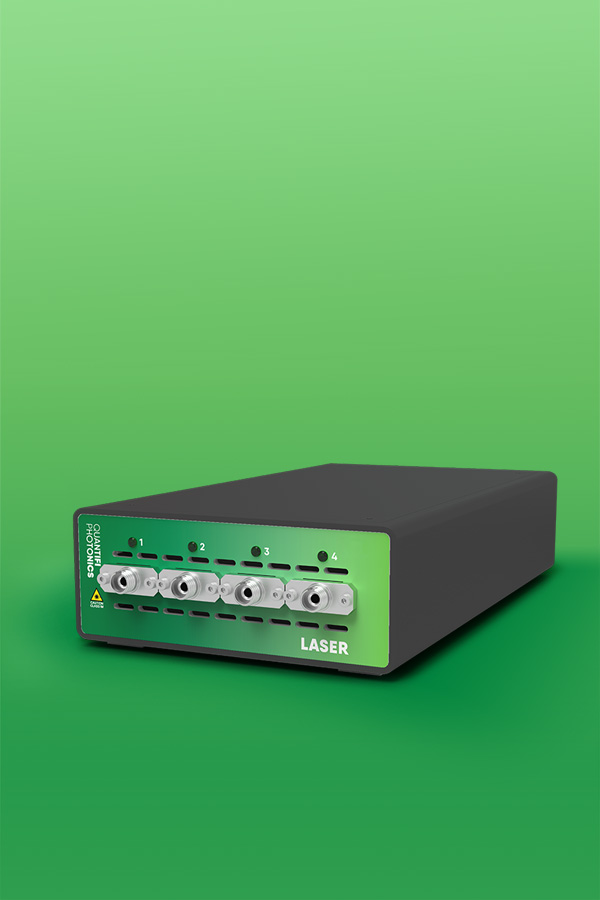Tunable Laser Source.
Available in MATRIQ and PXI platforms

Laser 1000 Series
The Laser 1000 Series is a fully-compliant micro-ITLA laser with up to four channels in a compact benchtop form factor.
Offering 0.01 pm resolution tunability across C or L bands, exceptional power accuracy up to 16.5dBm, and optional dither suppression, this is a versatile and cost-effective general purpose instrument.
Full tunability across C band or L band
Ideal for telecommunications applications; full coverage of DWDM channels.
Smarter calibration for enhanced power uniformity
Minimize inter-channel power variance with enhanced power uniformity between channels.
0.01pm tuning resolution
Tune to anywhere within C or L band with a high 0.01pm tuning resolution.
Narrow 100kHz linewidth, up to 16.5 dBm of power
High stability 100kHz linewidth makes it an ideal candidate for some of the most demanding applications, such as coherently modulated high-speed communications.
Polarization maintaining output
The slow axis of polarization is aligned with the output connector key as per industry standards. The user may choose to use polarization maintaining (PM) fiber or standard singlemode fiber (SMF).
Powerful software controls
The Laser 1000 Series is fully programmable via industry standard SCPI protocols and drivers are available for Python and LabVIEW. It also comes with an easy-to-use GUI that can be used on any device with a modern web browser.
USB or Ethernet operation
Connect via USB or Ethernet for simple setup and operation.
Excellent measurement correlation with our optical PXI modules
Shared product architecture lets you validate your system and test requirements in the lab with the benchtop version, and scale up to high-volume automated production testing with the Laser 1000 Series PXIe module.
Optional Whisper Mode
The Laser 1000 Series comes with optional whisper mode. This feature enables the user to temporarily disable the laser control frequency dither, which is useful for applications that require the narrowest linewidth.
All of our tunable lasers adhere to the OIF standard Micro Integrable Tunable Laser Assemblies (μITLA) Implementation Agreement and utilise the standard dithering method for frequency stability.
- Coherent optical transceiver development and testing
- Optical component development and testing:
- Optical splitters
- Optical couplers
- Optical Demultiplexers / Multiplexers
- Optical modulators
- Optical resonators
- MEMs testing
- Bragg Filter testing
- Fiber optic transmission testing
- Local oscillator for Tx and Rx coherent transceivers
- WDM / DWDM channel loading stress test
- Silicon photonic wafer waveguide testing
- EDFA optical amplifier testing
- Photonic Doppler Velocimetry (PDV) laser source
- Interferometry (broad field; includes medical imaging via interferometry, Mach-Zehnder instruments)
- High Performance Computing (HPC) with optical PIC-based semiconductors: channel loading
- General purpose stable light source for telecom and physics
Measuring Laser Linewidth
Low linewidth lasers are important for use in systems such as coherent communications, fiber optic sensors, interferometric sensing and gas detection. This application note covers the theory and importance of laser linewidth measurements, especially as they relate to low-linewidth lasers.
Measuring Laser LinewidthMulti-Channel PDV Systems
In this video, David McCormick, Technical Sales Manager for North America, provides an overview of Photon Doppler Velocimetry (PDV) and provides in-depth examples of how to integrate multi-channel and multiplexing techniques using Coherent Solutions instruments in your PDV test system.
Hardware Triggering of Quantifi Photonics’ PXIe Optical Modules
PXI’s integrated timing and hardware triggering capabilities offer a number of advantages over more traditional software-initiated measurements. Learn how to make the best use of the hardware triggering capability present in Quantifi Photonics’ PXIe photonics modules.
Hardware Triggering of Quantifi Photonics’ PXIe Optical ModulesRelative Intensity Noise (RIN) Measurement
Semiconductor laser Relative Intensity Noise (RIN) is an important parameter that can cause significant degradation to the performance of fiber optic communication links. It is important for both laser manufacturers and systems designers to understand how RIN is measured to ensure reliable, accurate and repeatable results.
Relative Intensity Noise (RIN) Measurement






